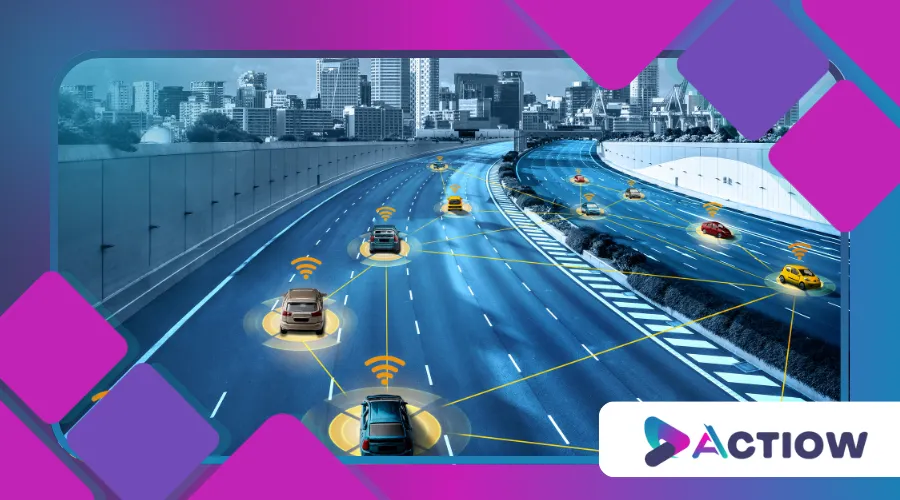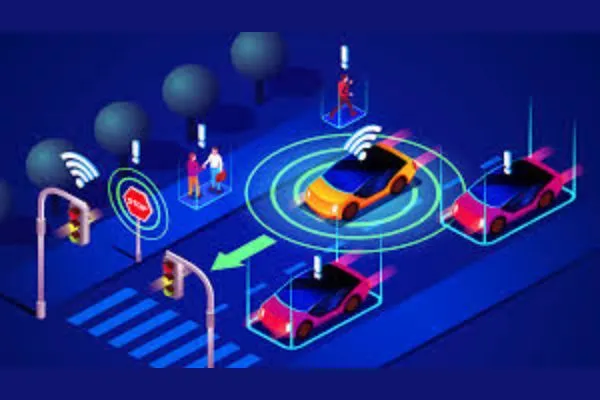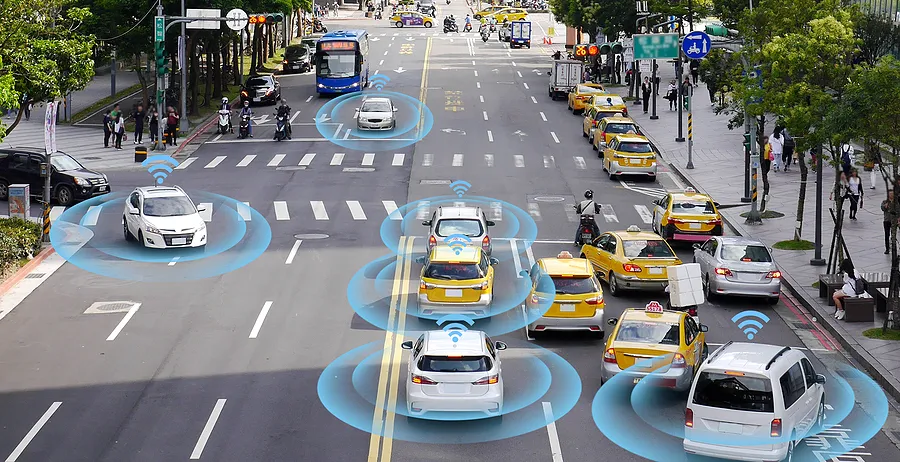How Vehicle-to-Everything (V2X) Tech Is Reshaping Urban Mobility

Anúncios
Vehicle-to-Everything (V2X) tech is quietly revolutionizing how cities move, think, and breathe.
Imagine a bustling urban artery where cars, traffic lights, and even pedestrians communicate in real-time, like a symphony conductor guiding an orchestra to perfect harmony.
This isn’t science fiction—it’s the promise of interconnected mobility, where vehicles don’t just travel but actively collaborate with their surroundings to create safer, smarter, and more sustainable cities.
Anúncios
As urban populations swell and traffic congestion costs billions annually, V2X technology emerges as a beacon of innovation, poised to redefine how we navigate the concrete jungle.
But what does this mean for the future of urban mobility, and how close are we to realizing its full potential?
In addition to enhancing safety and efficiency, V2X technology can also improve the overall quality of urban life.
By reducing traffic congestion and emissions, cities can become more pleasant places to live, fostering healthier communities and promoting outdoor activities.
The Core of V2X: A Networked Ecosystem
At its heart, V2X technology enables vehicles to communicate with everything—other cars (V2V), infrastructure (V2I), pedestrians (V2P), and even the cloud (V2C).
This dynamic network relies on advanced sensors, 5G connectivity, and edge computing to share data instantaneously, creating a web of intelligence that anticipates and reacts to real-world conditions.
Unlike traditional automotive systems, which operate in isolation, V2X thrives on collaboration.
A car approaching an intersection, for instance, might receive a signal from a smart traffic light warning of a pedestrian crossing, prompting it to slow down before the driver even notices.
Consider a hypothetical scenario in downtown Chicago: Sarah, driving her V2X-enabled sedan, approaches a busy intersection during rush hour.
Her car’s dashboard alerts her to a cyclist in her blind spot, detected via V2P communication, while simultaneously receiving data from a nearby traffic signal (V2I) that adjusts its timing to ease congestion.
This seamless interplay reduces the risk of collisions and keeps traffic flowing.
Such examples illustrate how V2X tech transforms reactive driving into proactive decision-making, enhancing safety and efficiency.
Moreover, as V2X technology matures, we can expect even more sophisticated applications, such as vehicle platooning and coordinated traffic management systems.
These advancements could lead to smoother traffic flow and further reductions in accidents, making urban environments safer for everyone.
Safety First: Reducing Urban Collisions
One of the most compelling arguments for V2X technology is its potential to save lives.
Urban areas, with their dense mix of vehicles, cyclists, and pedestrians, are hotspots for accidents.
According to the National Highway Traffic Safety Administration (NHTSA), over 38,000 fatalities occurred on U.S. roads in 2023, with urban areas accounting for a disproportionate share.
V2X tech addresses this by enabling vehicles to “see” beyond human limitations—around corners, through fog, or in chaotic traffic scenarios.
For example, in a pilot program in Ann Arbor, Michigan, V2X-equipped vehicles communicated with each other to prevent rear-end collisions at busy intersections.
When a lead car braked suddenly, V2V signals alerted trailing vehicles in milliseconds, giving drivers or autonomous systems critical time to react.
This capability could reduce rear-end crashes, which make up nearly 30% of urban accidents, by providing split-second warnings that human reflexes can’t match.
Isn’t it remarkable to think that a car could act faster than our own instincts?
Table 1: Impact of V2X Tech on Urban Safety
| Feature | Benefit | Example Application |
|---|---|---|
| V2V Communication | Reduces rear-end and side collisions | Alerts for sudden braking |
| V2P Communication | Protects pedestrians and cyclists | Blind-spot detection for vulnerable road users |
| V2I Communication | Enhances intersection safety | Smart traffic signals adjust timing |
Additionally, the implementation of V2X technology can lead to a cultural shift in how we perceive road safety.
As drivers become more aware of their surroundings through enhanced communication, there may be a greater emphasis on responsible driving behaviors.
+ Bidirectional Charging Technology: What It Is and How It Works
Easing Congestion: Smarter Traffic Flow
Beyond safety, V2X technology tackles one of urbanites’ greatest frustrations: gridlock.
Congested roads waste time, fuel, and patience while contributing to air pollution.
By enabling vehicles to communicate with traffic infrastructure, V2X optimizes traffic flow in ways that traditional systems can’t.
Smart traffic lights, for instance, can adjust their cycles based on real-time traffic data relayed from approaching vehicles, reducing wait times and preventing bottlenecks.
Picture a delivery truck in Los Angeles navigating a crowded downtown route.
Using V2I communication, the truck shares its position and destination with a network of traffic signals, which dynamically adjust to prioritize its path during a low-traffic window.
This not only speeds up deliveries but also reduces idling emissions.
Studies suggest that V2X-enabled traffic management could cut urban congestion by up to 15%, saving cities billions in economic losses annually.
This isn’t just about faster commutes; it’s about reclaiming time and reducing the environmental toll of urban sprawl.
Moreover, as cities adopt V2X technology, the potential for integrated public transportation systems increases.
Transit vehicles could communicate with traffic signals to ensure timely arrivals and departures, further enhancing the efficiency of urban mobility.

Sustainability: A Greener Urban Future
Cities are under pressure to meet ambitious sustainability goals, and V2X tech plays a pivotal role in this transition.
By optimizing driving patterns and reducing congestion, V2X systems lower fuel consumption and greenhouse gas emissions.
Electric vehicles (EVs) equipped with V2X can also communicate with charging stations (V2G, or Vehicle-to-Grid), balancing energy demand by feeding surplus power back to the grid during peak hours.
Think of V2X as a digital choreographer, ensuring that every vehicle, charging station, and traffic system moves in sync to minimize waste.
For instance, a 2024 study by the International Energy Agency found that V2G integration could reduce urban CO2 emissions from transportation by 10% by 2030 if widely adopted.
This synergy between V2X and green tech positions cities to meet climate targets while maintaining mobility.
Table 2: Environmental Benefits of V2X Tech
| V2X Component | Environmental Impact | Potential Reduction |
|---|---|---|
| V2I (Traffic Optimization) | Lower idling and fuel consumption | 10-15% reduction in urban emissions |
| V2G (Vehicle-to-Grid) | Balances energy demand, supports renewables | 10% CO2 reduction by 2030 (IEA, 2024) |
| V2V (Eco-Driving) | Promotes smoother driving patterns | 5-10% fuel savings |
Additionally, as cities prioritize sustainability, V2X technology can facilitate the integration of renewable energy sources into urban transportation systems.
This shift not only benefits the environment but also encourages the adoption of electric vehicles among residents.
You can learn more about sustainable urban mobility initiatives on the International Energy Agency website.
Challenges: The Road Ahead
Despite its promise, V2X technology faces hurdles that could slow its urban rollout.
Interoperability remains a key challenge—different manufacturers and cities must agree on standardized communication protocols to ensure seamless integration.
Without universal standards, a Ford equipped with V2X might not “talk” to a Toyota or a city’s infrastructure, creating fragmented systems.
Cost is another barrier.
Retrofitting existing vehicles and infrastructure with V2X tech requires significant investment, and cash-strapped municipalities may hesitate to prioritize it.
Cybersecurity also looms large: a networked ecosystem is vulnerable to hacking, and a single breach could disrupt entire city grids.
These challenges demand collaboration between governments, automakers, and tech firms to build trust and infrastructure.
Moreover, public awareness and education play crucial roles in overcoming skepticism surrounding V2X technology.
Engaging communities in discussions about the benefits and safety of V2X can help foster a more supportive environment for its adoption.
The Role of 5G and AI in V2X Evolution
The backbone of V2X technology lies in 5G networks and artificial intelligence.
5G’s low latency—often under 10 milliseconds—ensures real-time data exchange, critical for split-second decisions in dense urban environments.
AI, meanwhile, processes the flood of data from vehicles, sensors, and infrastructure, predicting traffic patterns and optimizing routes.
Together, they create a responsive, adaptive system that learns from every interaction.
For example, in Singapore’s Smart Nation initiative, V2X systems powered by 5G and AI have reduced average commute times by 12% in pilot zones by dynamically rerouting traffic based on real-time conditions.
This fusion of technologies isn’t just improving mobility; it’s redefining how cities function as living, breathing organisms.
Additionally, as 5G networks expand globally, the potential for V2X technology to flourish increases.
This connectivity will enable more vehicles and infrastructure to join the network, enhancing the overall effectiveness of urban mobility solutions.

Policy and Public Adoption: The Human Factor
Technology alone won’t reshape urban mobility—people and policies will.
Public acceptance hinges on trust in V2X systems, particularly regarding data privacy.
Drivers may balk at sharing real-time location data, fearing surveillance or misuse.
Clear, transparent policies are essential to address these concerns and build confidence.
Governments also play a critical role.
Incentives like tax breaks for V2X-equipped vehicles or funding for smart infrastructure can accelerate adoption.
Cities like Amsterdam, which have invested heavily in V2I systems, show how policy can drive progress.
Without coordinated efforts, V2X risks remaining a niche technology rather than a transformative force.
Moreover, fostering partnerships between public and private sectors can enhance the implementation of V2X technology.
Collaborative efforts can lead to innovative solutions and shared resources, ultimately benefiting urban mobility as a whole.
++ Cars with 360-Degree Cameras: How They Make Driving Easier
The Future: A City That Talks Back
Looking ahead, V2X technology could redefine urban planning itself.
Imagine cities designed not around roads but around communication networks, where mobility is as much about data as asphalt.
Autonomous vehicles, fully integrated with V2X, could eliminate the need for traffic lights altogether, as cars negotiate intersections in real-time.
Pedestrians, equipped with V2P devices, could move safely through urban spaces, confident that vehicles are aware of their presence.
This vision isn’t distant.
Pilot programs in cities like Singapore, Ann Arbor, and Amsterdam are laying the groundwork, and automakers like Ford and Toyota are embedding V2X in new models.
By 2030, the global V2X market is projected to reach $12.7 billion, driven by urban demand for smarter mobility.
The question isn’t whether V2X will reshape cities, but how quickly we can embrace it.
Additionally, as urban populations continue to grow, the need for efficient mobility solutions will become even more pressing.
Cities that adopt V2X technology early may gain a competitive advantage, attracting residents and businesses eager for innovative infrastructure.
Conclusion: A New Urban Rhythm
Vehicle-to-Everything (V2X) tech is more than a tool—it’s a paradigm shift, weaving vehicles, infrastructure, and people into a cohesive, intelligent network.
From slashing accidents to easing gridlock and curbing emissions, its benefits are as diverse as the cities it aims to transform.
Yet, its success depends on overcoming technical, financial, and social barriers through collaboration and innovation.
As cities grow and challenges mount, V2X offers a path to a safer, greener, and more efficient urban future.
Will we seize this opportunity to let our cities talk back, or will we remain stuck in the traffic of yesterday’s solutions?
Ultimately, the future of urban mobility lies in our hands.
By embracing V2X technology and supporting its development, we can create cities that not only function better but also enrich the lives of everyone who calls them home.
